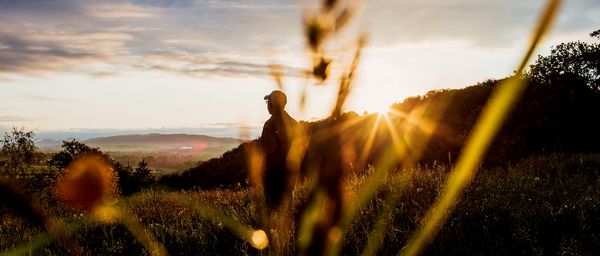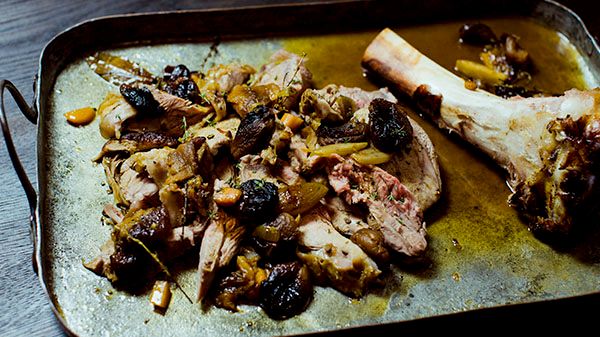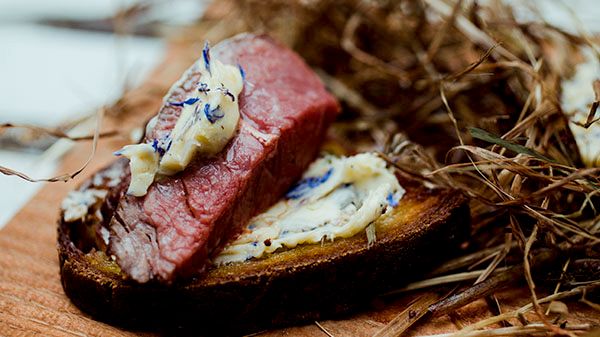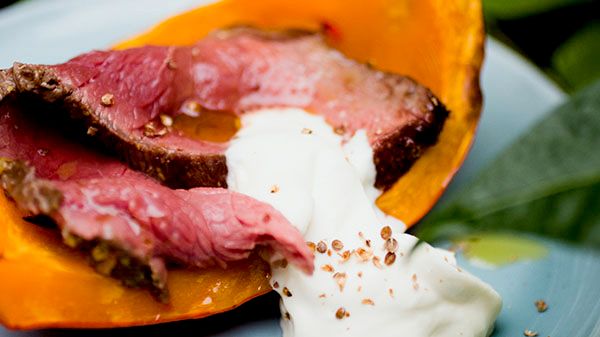a satiny, black coat, shiny nostrils and a brawny body made up of 100 percent pure Wagyu meat – the breeding bull Abramovich from Abermule is an incredibly massive animal. This powerful fellow with the proud Russian name is the jewel of Ifor Humphreys’ herd in northern Wales. This bull has it good: In the lush pastures of the hilly countryside that are as bright green as Asian rice paddies after a monsoon, Abramovich is able to inseminate his cows naturally – without technological aids. “He’s a credit to his name,” says breeder Humphreys, proudly adding: “He can easily handle 40 cows.” Per season, of course.
Ifor Humphreys’ happy cows
These Japanese cattle are the newest stars on the gastronomic horizon. Now they’re also being raised in Europe. A visit to a breeder in the heart of grass-green Wales.
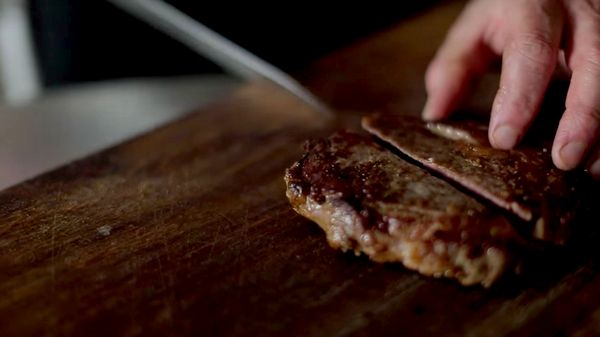
Wagyu beef: tender temptation from Wales
The small village of Abermule is located in the lush green hills of Montgomeryshire. Agriculture and raising livestock has been part of the tradition here for generations. Breeder Ifor Humphreys feels like he is part of this tradition even though he has his own approach. The small herd of Wagyu cattle that he breeds is a perfect example of the highest quality requirements in a market influenced by mass production.

Who is Ifor Humphreys?
This Welsh farmer’s operation is the antithesis of mass production. When he visits his cows in the pasture, he greets them with a fond “Hi girls.” Ifor Humphreys, 50, comes from a farming family. His father and grandfather raised livestock, mainly sheep. For seven years, Ifor Humphreys has been raising Wagyu cattle. He also owns a forest cemetery where village residents, neighbours and friends can find their final resting place.
800 kilograms live weight

Wagyu meat has unique marbling.
“The finest veins of fat run through the meat and melt when cooked, making it indescribably juicy, tender, and flavourful” Raising Wagyu cattle puts Humphreys far ahead of the curve. Connoisseurs look upon Wagyu meat as the ultimate delicacy, and it is currently in high demand. On the market it sells at a premium price of around 200 euros per kilogram of tenderloin – much more if the quality is especially high.
It’s been seven years since the Welsh farmer and third-generation breeder seized the opportunity to switch from traditional breeds such as Angus and Limousin to Wagyu cattle. Fifty-year-old Humphreys had heard about the quality of this Japanese breed – which is now also being raised in the U.S. and Australia – and decided to import an embryo. Nine months later, Abramovich, the breeding bull, was born.

I have a great respect for organic structures
This bizarre-sounding story of a test tube birth is as far as modern technology goes. Upper Bryntalch Farm in Wales operates much as it did in the previous century. It’s a deliberate choice.“I have a great respect for organic structures,” explains Ifor Humphreys as he chugs along in his 60-year-old Fordson Major Diesel. He’s on his way to visit the pasture where 40 cows and calves graze peacefully alongside a herd of 300 sheep and eat their fill of juicy Welsh pasture grass. Sometimes a new calf that was born during the night and can be seen taking its first steps in the early morning. “Wagyus calve easily, which is why they’re able to give birth up here on natural pastures,” says the breeder.
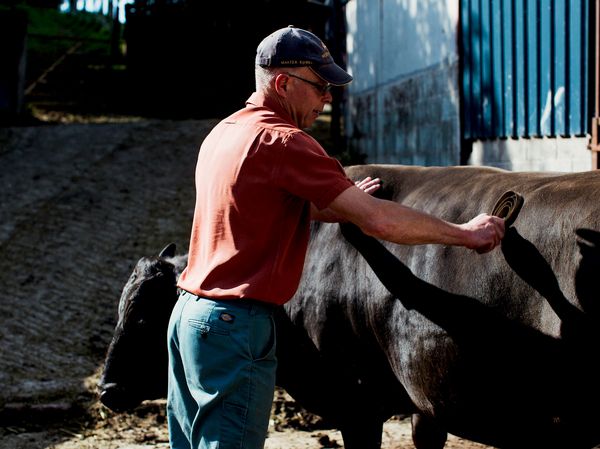
“My animals aren’t used to human contact. I try to calm them with massages.”
In contrast to other cattle breeds, which are ready for slaughter at just over 18 months, Wagyus can live up to 30 months. During their final 5 months, they’re kept in a stall to monitor their weight and gradually prepare them for eventual transport. “That’s also when we start giving them massages and a daily ration of beer,” says Humphreys. In Japan the cattle are massaged to keep them from losing muscle tone in the stall and they’re given beer to stimulate their appetite in hot weather. Ifor Humphreys follows this tradition, though for different reasons: He wants his cattle to become accustomed to human touch.“In the long production chain, transport and slaughter are the weakest links,” says the experienced breeder.
Wagyu Beef - Quality that justifies ist price.
Wagyu beef (sometimes incorrectly called Kobe beef) originally came from Japan but its export is still prohibited. Populations outside the Kobe region came from animals that were shipped to Australia via the U.S. in the mid-1990s for scientific purposes. What is so special about the meat from this breed? For centuries these animals were used only as beasts of burden until, through outside influences, the Japanese came to appreciate the taste of beef. “The result was a bloodline with intramuscular fat that runs through the meat in fine lines and is responsible for its especially fine flavour,” says Rachel Godwin from Alternative Meats. This Welshwoman is one of Britain’s few female meat experts and markets Ifor Humphreys’ meat in renowned shops including, for example, the food department at Harrod’s in London.
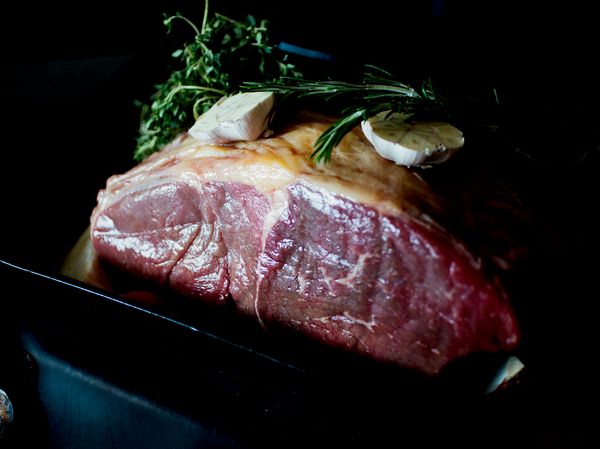
“The higher the percentage of intramuscular fat, the better the quality.”
It can reach up to 12 points on the marbling scale, which is the equivalent of Robert Parker’s points for select wines. In Europe, however, such scores are extremely rare. Humphreys’ meat, which is a cross between Wagyu and Angus or Limousin, achieves scores of around 6. By the way, you can order the meat online and have it delivered directly to your home.
With aging, the meat becomes unbelievably tender and develops a variety of unimaginable flavours.
60 kg is the average amount of meat – mainly pork – that Germans eat per year. Americans eat 92 kg, although in their case it’s almost exclusively poultry.. 85% is the humidity level required for dry aging. This is the process by which good meat is made even better. At temperatures of 2 to 3°C, the meat loses weight during the process and by the end may weigh up to a third less. This makes the meat more tender – and more expensive.
71% of those surveyed by the GfK market research institute said they would be willing to pay more for good meat.
170 euros is the cost of 250 grams of tender Wagyu filet mignon with a quality score of 9+.
85% of Germans eat meat almost daily. According to recent studies, organic beef accounts for six percent of the market.
81% of consumers would even buy local meat if it were available.

The best cut, flavour, and Quality meat
The quality of Wagyu beef is so high that you don’t necessarily need to eat filet mignon. Rib eye, T-bone, and chuck steaks also have an intense flavour. Intramuscular fat gives the meat a delicate, mellow flavour. Sauce would be a sin, which is why Wagyu beef in restaurants is always served plain, usually unaccompanied by side dishes.
HIGH-QUALITY MEAT IS GOOD FOR YOU
Beef is 21 percent protein. Because of its specific amino acids, this protein is easily metabolised by our bodies.
Excellent meat requires very little salt, pepper or oil. Simply drizzle with oil and place straight into the pan. The heat will caramelize the outside layer of the meat, creating an incomparable flavour. Crisp on the outside, juicy and finely marbled on the inside: an explosion of flavour on the tongue that is not soon forgotten.
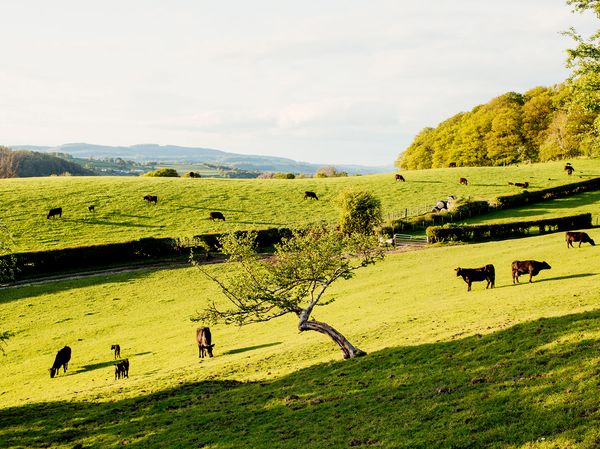
Humphreys sums it up
There’s more than one way to raise animals. Anyone who eats meat should do so with respect and awareness that an animal gave its life.” He believes that extraordinary quality and correspondingly high prices are necessary steps on the way to conscious enjoyment. It may sometimes cost as much as 100 euros. That’s a lot of cash, even for someone who makes good money. But once people have been educated, they never want to eat industrial meat again. They would rather have high quality less often if means having a flavour experience.
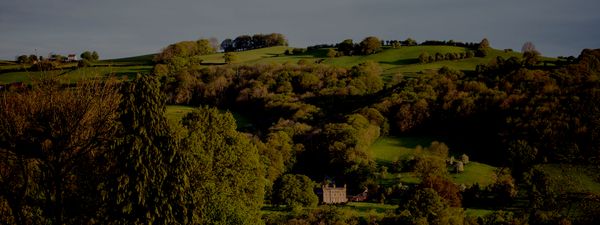
Where is Abermule?
Abermule is a small village in Montgomeryshire in central Wales. The Severn, Great Britain’s longest river, runs through Abermule. Road signs throughout the region are first written in Welsh and then in English, which is somewhat controversial politically. Welsh efforts toward independence are not always seen as positive by the rest of the United Kingdom.
